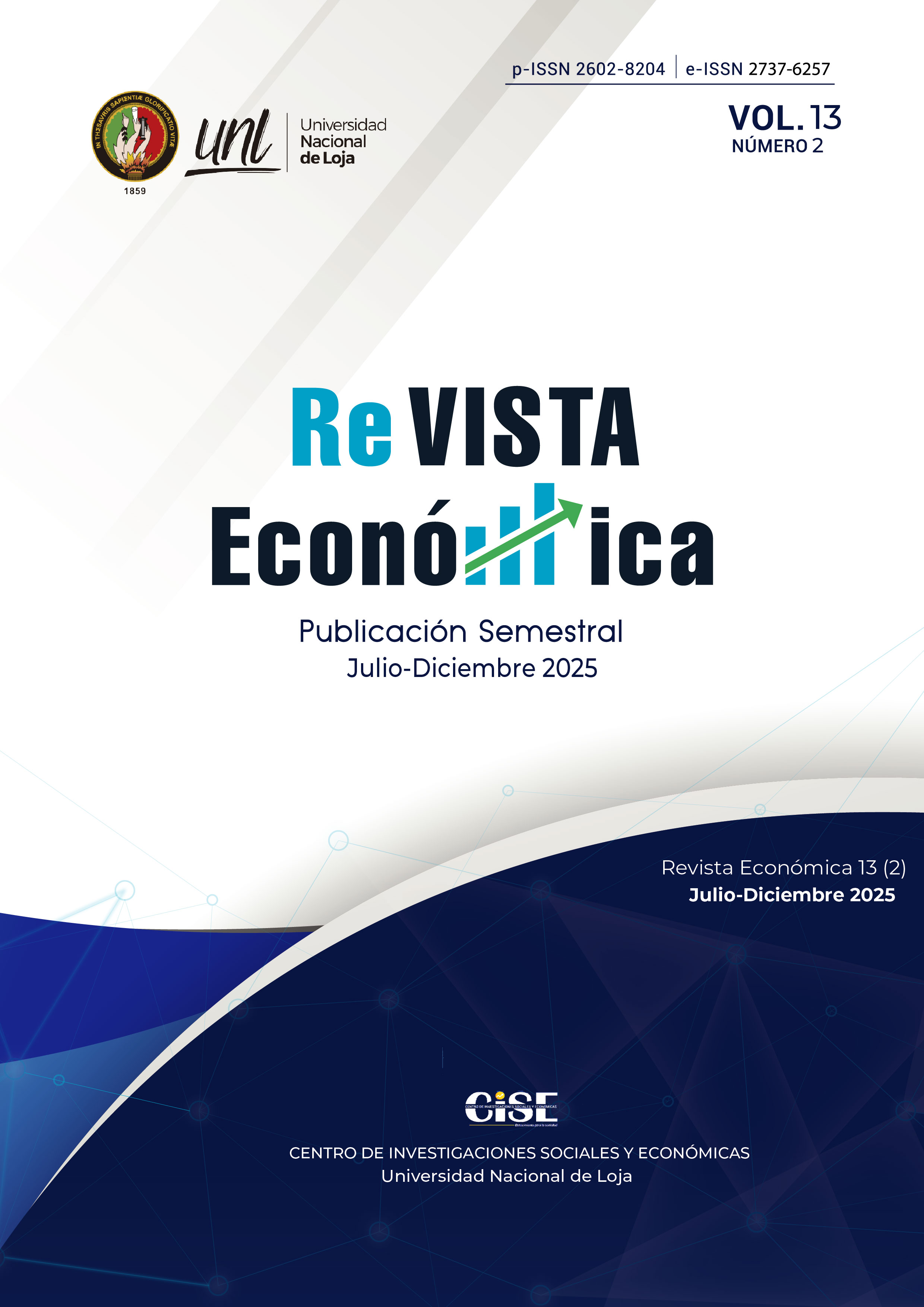Determinants of health spending in El Salvador
Main Article Content
Abstract
Article Details

This work is licensed under a Creative Commons Attribution-NonCommercial-NoDerivatives 4.0 International License.
Esta obra está sujeta a la licencia Reconocimiento-NoComercial-SinObraDerivada 4.0 Internacional de Creative
Commons. Para ver una copia de esta licencia, visite http://creativecommons.org/licenses/by-nc-nd/4.0/.
References
[1] Amemiya, Takeshi, 1983. "Non-linear regression models," Handbook of Econometrics, in: Z. Griliches† & M. D. Intriligator (ed.), Handbook of Econometrics, edition 1, volume 1, chapter 6, pages 333-389, Elsevier https://doi.org/10.1016/S1573-4412(83)01010-7.
[2] Arrow, Kenneth J. (1963) “Uncertainty and the welfare economics of medical care”, The American Review, 53(5), 941-973. https://assets.aeaweb.org/asset-server/files/9442.pdf
[3] Ayala-Beas SR y Rodriguez Minaya YE. Gasto en salud y resultados en salud en América Latina y el Caribe, Rev Panam Salud Pública. 2023; 47: e136. https://doi.org/10.26633/RPSP.2023.136
[4] Becker G. S. (1964, 1993) Human Capital: A Theoretical and Empirical Analysis, with Special Reference to Education, Chicago, University of Chicago Press, 3ème éd.
[5] Becker, Gary (1976) The economic approach to human capital, The University of Chicago Press, 314p
[6] Box, G.E.P. and Cox, D.R. (1964) An Analysis of Transformations. Journal of the Royal Statistical Society, Series B, 26, 211-243. https://doi.org/10.1111/j.2517-6161.1964.tb00553.x
[7] Cylus J0nathan, Sarah Thomson y Tamás Evetovits, (2018) Catastrophic health spending in Europe: equity and policy implications of different calculation methods. Bull World Health Organ. 2018 Sep 1;96(9):599-609. doi: 10.2471/BLT.18.209031. Epub 2018 Jun 4. PMID: 30262941; PMCID: PMC6154073.
[8] Friedman, Milton (1957) Theory of the Consumption Function, chapter II The Implications of the Pure Theory of Consumer Behavior, Published by: Princeton University Press Stable, https://www.jstor.org/stable/j.ctv39x7zh URL: http://www.jstor.com/stable/j.ctv39x7zh.5
[9] Grossman, Micheal (1972) On the Concept of Health capital and the Demand,Página 29 de 1 for Health, Journal of Political Economic, Vol. BO: 223-255, https://mgrossman.ws.gc.cuny.edu/files/2017/06/conceptofhealthcap.pdf
[10] Guajati, Damodar N. y Dawn C. Porter (2010) Econometría, 5ª. Ed. Mc Graw Hill, 921p.
[11] Johnston, Jack, (1985) Méthodes économetriques, tome 1, Ed. Économica, Paris, 347p
[12] Judge G. George et al, (1988) Introduction to the theory and practice of econometrics, Second edition, Ed. John Wiley &Sons, 1024p.
[13] Karsten, Sifrieded. Guenther. (1995). Health Care: Private Good vs. Public Good.The American Journal of Economics and Sociology, 54(2), 129–144. http://www.jstor.org/stable/3487569
[14] Mohanty SK, Kastor A. Out-of-pocket (2017) expenditure and catastrophic health spending on maternal care in public and private health centers in India: a comparative study of pre and post national health mission period. Health Econ Rev. 2017 Sep 18;7(1):31. doi: 10.1186/s13561-017-0167-1. PMID: 28921477; PMCID: PMC5603466.
[15] OMS (2023) Director-General's opening remarks at the World Health Assembly, https://www.who.int/director-general/speeches/detail/who-director-general-s-opening-remarks-at-the-media-briefing-5-may-2023
[16] OMS (2017) Tracking universal health coverage: 2017 global monitoring report. World Health Organization and International Bank for Reconstruction and Development / The World Bank; 2017. Licence: CC BY-NC-SA 3.0 IGO, 70p. https://www.who.int/publications/i/item/9789241513555
[17] OMS (2019) 141ª Plenary Assembly of the Inter-Parliamentary Union, Belgrade, Serbia, 13-17 October 2019,
[18] OPS (1999) El gasto de bolsillo en salud en américa latina y el caribe: razones de eficiencia para la extensión de la protección social en salud, Documento preparado para la reunión regional tripartita de la OIT con la colaboración de la OPS, Extensión de la protección social en salud a los grupos excluidos en américa latina y el caribe México, 29 de noviembre al 1 de diciembre de 1999, 29p
[19] OPS (2018) Espacio Fiscal Para La Salud En América Latina Y El Caribe, Washington, D.C.: OPS, -1, 2018. https://iris.paho.org/handle/10665.2/34947.
[20] Perticara, Marcela (2008), In
[21] cidencia de los gastos de bolsillo en salud en siete países latinoamericanos, CEPAL - Serie Políticas sociales No 141, https://hdl.handle.net/11362/6146
[22] Petrera Pavone M, Jiménez Sánchez E. (2018) Determinantes del gasto de bolsillo en salud de la población pobre atendida en servicios de salud púbicos en Perú, 2010-2014. Rev Panam Salud Pública. 2018; 42: e20. https://doi.org/10.26633/RPSP.2018.20
[23] Philippe Batifoulier et Jean-Paul Domin (dir.) (2015) Économie politique de la santé. Un exemple exemplaire, Revue de la régulation, 17, 1er semestre, p7-18, https://journals.openedition.org/regulation/10274
[24] Restrepo, Jairo y Kristian Rojas, (2016) La génesis de la Economía de la Salud en Kenneth Arrow (1963) Universidad de Medellín, Lecturas de Economía - No. 84, enero-junio, pp209-242.
[25] Sanoussi Y, Zounmenou AY, Ametoglo M. (2023) Catastrophic health expenditure and household impoverishment in Togo. Journal of Public Health Research, 12(3). doi:10.1177/22799036231197196
[26] Schultz, Theodore W. (2019). Investing in people: the economics of population quality (Reprint 2019, Ser. The royer lectures). University of California Press. https://doi.org/10.1525/9780520318540
[27] Schultz, Theodore W. (1961). Investment in Human Capital. The American Economic Review, 51(1), 1–17. http://www.jstor.org/stable/1818907
[28] Sen, Amartya (2000) Desarrollo y Libertad, Barcelona, 220p
[29] Shackle,George Lennox Sharman (1951)The Economic Journal, Volume 61, Issue 241, 1 March 1951, Pages 131–134, https://doi.org/10.2307/2226615
[30] Stiglitz, Josep, (2000), La economía del sector público, Tercera edición, 2000, 379p.

